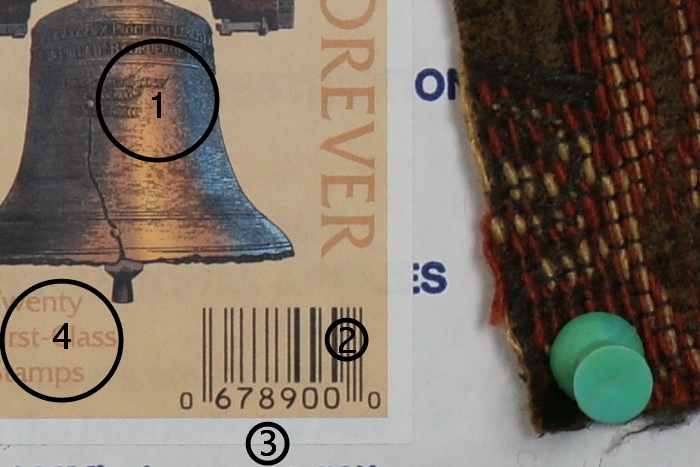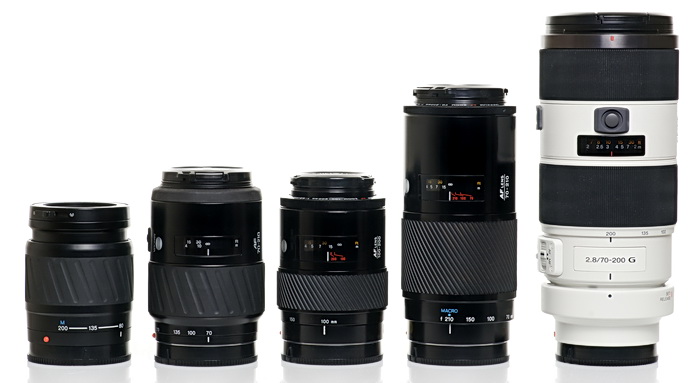This is a comparison between the lenses listed below, all crops were taken from the center of the image at 200mm or 210mm. If the image box is empty, that means the aperture listed is not available on that lens. The camera used for this comp is the Sony A900.
When looking at the crops, keep in mind the following information:
The subject is the larger cover sticker from a book of “forever” US stamps, with a piece of cloth on the right, both against a white cardboard box background. My crops aren’t exactly lined up, but close enough for our test purpose here. The green item is a thumb tack.
The distance from the lens to the subject is about 20 feet, or 6.1 meters, which might be about the same distance as you would get to a bird or small animal.
For all lenses, focusing was done manually, and samples were taken until the best possible sharpness was obtained, then the shot sequence was taken. The reason manual focus was used is because the camera’s focusing system was not always accurate enough when looking at 100% crops of 24mp images. Also, the focal length may appear less or more on certain lenses, that’s because of the focusing mechanism, which changes the effective focal length on that lens slightly.
Guide for beginners

In case you aren’t all that familiar with the nuances of image quality, I’ve added some circles with numbers to help point out areas that you’ll want to take note of. This image was taken closer than the real crops below, so I could enlarge it and put in the numbers for you to see.
1. Look at the very fine detail here, or lack thereof between the crops
2. This block of lines inside the circle is 3mm across, and don’t forget the distance is 20′ or 6.1m from the lens.
3. Look along the white border on the stamp, with the less expensive lenses, it almost vanishes among the white from the cardboard box background. A good lens will more clearly delineate the transition (acutance).
4. These letters are all fuzzed up on the less expensive lenses, and clearly discernible with the good ones, even at wide open apertures, it’s the same issue as no. 3 above.
Summery of each lens for this comparison.
Minolta AF 80-200mm F/4.5-5.6 shutter cap. This lens is very cheap on eBay, and seems to have slightly more contrast than the Minolta 100-200mm. Compared to the other more expensive lenses, it holds up very well. For some reason the F/8 shot looks softer than the F/5.6 shot, I don’t know why. I see even with a loss of 10mm focal length over two more expensive lenses, F/16 looks about as good as the rest of the bunch—weird!
Minolta AF 70-210mm F/3.5-4.5. This lens is as sharp, or almost as sharp as the Minolta 70-210mm F/4, (depending on aperture), but costs much less and has much less color fringing through F/5.6 in the centers.
Minolta AF 100-200mm F/4.5. I think this lens performs better at longer distances. In the review, it looked about the same as the Minolta F/4 lens below, or slightly sharper at F/8, but those results don’t seem to translate to this test session.
Minolta AF 70-210mm F/4. This lens seems to perform about the same at short or longer distances, a little soft wide open, then sharpening up with each stop down to about F/11. I see this is the only lens to produce noticeable color fringing in the centers, but it goes away by F/8.
Sony 70-200mm F/2.8 SSM G. Clearly the best image quality if you look closely, even considering it gives up 10mm to the other two good lenses.
Reminder; these crops were taken indoors with controlled conditions and at a fairly short distance. When you go outside and start shooting at distant objects, atmospheric haze and heat shimmer can destroy fine detail, so the differences you see in my indoor crops may not be so noticeable at long distances outside.
The lenses pictured below are the ones actually used in this comparison.
 |
| L to R, Minolta 80-200mm, Minolta 70-210mm, Minolta 100-200mm, Minolta 70-210mm F/4, Sony 70-200mm |
Let’s check out the crops below.
|
Minolta AF 80-200mm F/4.5-5.6
|
Minolta AF 70-210mm F/3.5-4.5
|
Minolta AF 100-200mm F/4.5
|
Minolta AF 70-210mm F/4
|
Sony 70-200mm F/2.8 G
|
|
|
F/4-4.5
|
 |
 |
 |
 |
|
|
F/5.6
|
 |
 |
 |
 |
 |
|
F/8
|
 |
 |
 |
 |
 |
|
F/11
|
 |
 |
 |
 |
 |
|
F/16
|
 |
 |
 |
 |
 |
|
I guess in the end, if you shoot at 200mm in bright conditions where you can use F/8-11, most of the lenses above will give adequate results. If you want the best image quality at large apertures, like F/4-5.6, you may want to step up to the expensive Sony 70-200mm F/2.8 SSM G, where of course you get F/2.8, which comes in handy in low light. I didn’t test it at F/2.8 in this comparison because the other lenses didn’t offer that aperture.
That’s it folks, hope you enjoyed it. |